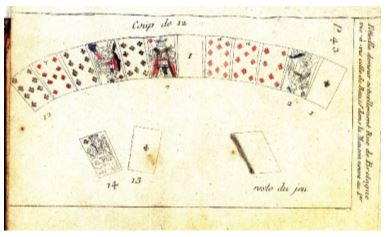Why and how Lenormand Reading is different from modern methods of Tarot Reading
by Caitlín Matthews
If you are familiar with Tarot and are wanting to approach Lenormand for the first time, then this might be a helpful place to start, to understand why and how reading Lenormand is so different. If you approach Lenormand with a cartomantic mindset, you will arrive prepared.
CARTOMANCY FLOURISHED BEFORE ESOTERIC TAROT
Cartomancy is the craft of divining from cards. While it is a word often applied to playing card reading these days, it is a useful term for anyone who is taking up Lenormand reading for the first time. Lenormand cards are read cartomantically, which is an older method of reading cards, which I’m going to outline here.
Before Tarot went esoteric, before Lenormand cards were even born, people were laying out playing cards and reading them by juxtaposition with each other. It is from this era that we inherit the cartomantic style of reading that is used in Lenormand.
The image below is Etteilla’s spread called le Coup de Douze (12 Card Spread – and yes, it does have two extra cards for ‘the surprise.’) This is taken from the very first published book which outlined practical cartomantic reading with a pack of 32 playing cards, The Only True Way to Read the Cards, published in 1773.
Etteilla read the cards from right to left (most modern readers read left to right today and that is still the case with Lenormand cards) and used reversed cards. We see that the carte blanche (the blank card that acted as the Significator) is centrally placed here. The cards either side of it, which touch the Significator are King Hearts and 10 Diamonds, signifying a Blond Man who has an abundance of money, respectively. The line is read by pairing card 1 with card 2, card 2 with card 3 etc. until the line is read. This method tells the story as cards blend together. Many years later this same Coup de Douze spread was taken up by the Golden Dawn and translated into the fiendishly complex Opening of the Key spread, which takes several hours to lay and read.
Here is the case in point: cartomancy is simple, pragmatic and non esoteric. It doesn’t depend on a knowledge of astrology, it doesn’t require you to know which phase the moon is in, you don’t need to know numerology. This is one of the reasons why Lenormand is non-esoteric in nature and why we read in the ways that we do now: because the reading style dates from before the esotericizing of tarot in the mid-late 18th which was begun by Court de Gebelin and Comte de Mellet, and to which Etteilla himself contributed, though not before recording his own cartomantic methods.
The older style of reading is one that is nowadays only used by playing card readers and cartomants who use small oracles like Lenormand. It comes from a different mindset and, without taking this on board, it’s easy to try and read Lenormand like Tarot, which won’t help you at all.
To be continued

Fantastic, clear, insightful and so very useful to both students and seasoned readers.
I am very pleased to begin reading about cartomancy and Lenormand from the very beginning to be able to construct a different mindset from reading the Tarot. Thank you for providing the means to do so.
Ahh! Thanks for posting this amazingly helpful history of the cartomantic method, Caitlin! Reblogging 🙂
This is great! I really like how you have made the distinction between esoteric and non-esoteric reading. One of the things that I find attractive about learning Lenormand IS the pragmatic, non-esoteric nature of the system. It’s a nice change of pace from my more familiar Tarot. I’m looking forward to reading your second post 🙂